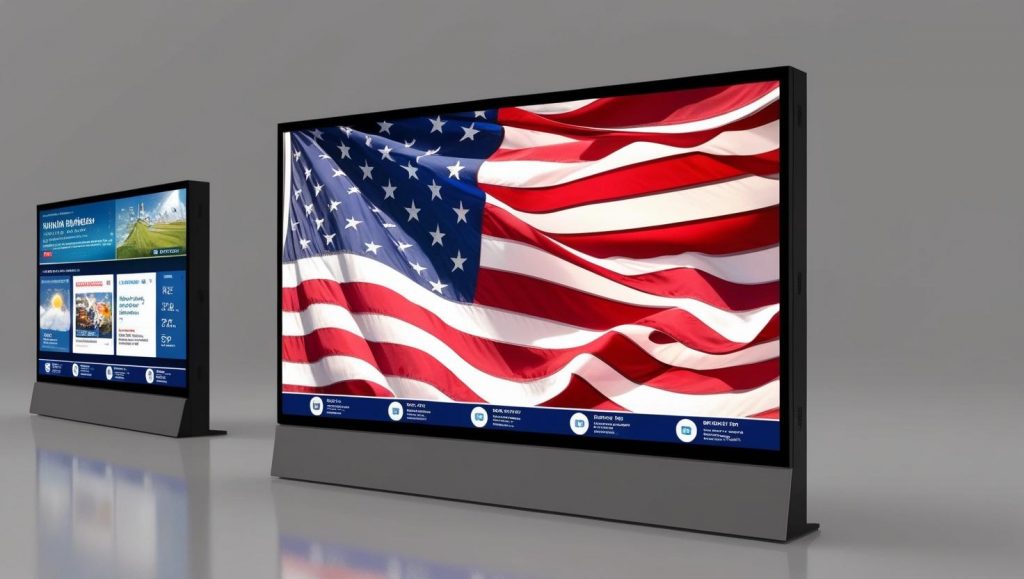In recent years, the digital signage industry has weathered its fair share of economic headwinds—perhaps none more disruptive than the tariffs implemented during the Trump administration. These tariffs, aimed primarily at Chinese imports, significantly impacted the cost structures of hardware-dependent industries, including digital signage. But with these policies now behind us or softened, a new chapter is beginning—one filled with renewed opportunity, innovation, and growth.
The Tariff Era: A Challenging Climate
Under the Trump administration, tariffs were imposed on a wide range of electronic components and finished goods, many of which are essential to digital signage systems—LCD panels, circuit boards, power supplies, and more. As a result, companies faced increased costs, longer lead times, and forced shifts in supply chain strategy. Smaller players in the market, especially those without diversified suppliers, struggled to stay competitive.
The industry’s rapid adoption slowed as businesses reevaluated their budgets. Hardware providers passed costs onto integrators and end-users, and projects were either delayed or scaled back. Innovation was deprioritized in favor of cost-cutting and survival.
Post-Tariff Landscape: A Rebound in Motion
Now, with many tariffs relaxed or repealed, and trade tensions easing, digital signage is entering a revival phase. Hardware prices are stabilizing, global supply chains are being rebuilt, and manufacturers are regaining the confidence to invest in R&D and product development.
This new environment is already producing results:
-
Increased affordability of displays and media players
-
Accelerated adoption across retail, healthcare, transportation, and hospitality
-
Greater innovation in software, including AI-driven content delivery and interactivity
-
Wider integration with IoT, edge computing, and data analytics
Request U.S Tariffs Impact Analysis Now @ https://www.marketsandmarkets.com/pdfdownloadNew.asp?id=513

Key Opportunities on the Horizon
1. Smart Cities and Public Infrastructure
Governments and municipalities are investing in smart infrastructure, including interactive kiosks, real-time transit displays, and digital wayfinding. With hardware costs declining, large-scale rollouts are more viable than ever.
2. Retail Reinvention
Brick-and-mortar is far from dead—it’s being reinvented. Dynamic digital signage is helping stores become immersive, personalized spaces. Post-tariff cost relief enables even small and mid-sized retailers to deploy advanced signage solutions.
3. Sustainability and Energy Efficiency
With fewer financial pressures, companies are focusing on eco-friendly display technology. Innovations like e-paper signage and energy-efficient LED panels are gaining traction, aligning with growing ESG demands.
4. Global Market Expansion
Emerging markets, previously priced out of the digital signage revolution, are now catching up. Lower hardware costs and flexible software solutions are enabling rapid growth in Latin America, Southeast Asia, and Africa.
Looking Ahead: Navigating a New Normal
The digital signage industry is now poised to move from a reactive phase to a proactive one. Companies that embraced flexibility during the tariff period—by diversifying suppliers, adopting cloud platforms, or developing modular systems—are now reaping the rewards.
As tariffs become a memory rather than a roadblock, the focus is shifting back to experience: How do we create more engaging, intelligent, and seamless content for increasingly connected audiences?
The post-Trump tariff era offers a clean slate for the digital signage market. With financial burdens easing and innovation accelerating, companies now have the chance to turn past obstacles into future advantages. The message is clear: the screen is no longer just a display—it’s a gateway to opportunity.
The future of digital signage isn’t just digital—it’s dynamic, diversified, and full of opportunity.
